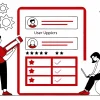
How To Address Negative Feedback Constructively?
In any industry, feedback is crucial for continuous improvement. While positive feedback can boost morale, negative feedback presents valuable growth opportunities. It’s essential to understand why negative feedback is vital for organizations.
Feedback provides insights into customer experiences, highlighting areas that need improvement. By understanding feedback, organizations can enhance service quality and overall performance.
Effective Strategies To Tackle Negative Feedback
Addressing negative feedback constructively can lead to better customer relationships, improved services, and a more robust reputation for your business. Let’s explore a step-by-step approach to handling negative feedback:
Step 1: Listen To The Feedback Carefully
Listening is the first and most crucial step in addressing feedback. It sets the tone for all subsequent actions.
- Active Listening Techniques: Active listening involves paying full attention, acknowledging the concerns raised, and not interrupting. This demonstrates empathy and respect for the individual’s feelings.
- Importance of Non-Verbal Cues: Non-verbal cues like nodding and maintaining eye contact reinforce that you are engaged and taking the feedback seriously. This can help de-escalate any negative emotions the individual may have.
Step 2: Acknowledge The Feedback
Acknowledging feedback shows that you value the input and are committed to addressing the concerns.
- Expressing Gratitude: Thank the individual for their feedback, regardless of its nature. This gratitude can make them feel heard and appreciated.
- Validating Concerns: Validate their concerns by recognizing the issues they raised. This doesn’t mean you have to agree with everything, but showing understanding can foster trust.
Step 3: Investigate The Issue
A thorough investigation into the feedback is essential to understand the root cause of the problem.
- Gathering Information: Collect detailed information about the issue from all relevant sources, including staff involved and any relevant records.
- Analyzing the Feedback: Analyze the feedback to identify patterns or systemic issues that need addressing. This helps in finding effective solutions.
Step 4: Communicate Your Findings
Clear communication of your findings is crucial to maintain transparency and trust.
- Choosing the Right Communication Channel: Select the appropriate channel to communicate, whether it’s a phone call, email, or face-to-face meeting, based on the severity and nature of the feedback.
- Delivering Your Message: Be concise and clear in your communication. Explain what you found during the investigation and what steps will be taken to address the issue.
Step 5: Implement Solutions
Addressing the feedback effectively requires implementing appropriate solutions.
- Immediate Corrective Actions: Take immediate steps to rectify the situation if possible. This shows promptness and seriousness in resolving the issue.
- Long-Term Improvements: Implement long-term improvements to prevent recurrence. This might involve policy changes, staff training, or process enhancements.
Step 6: Follow-Up Action
Following up ensures the individual feels valued and reassures them that their feedback has led to meaningful change.
- Scheduling Follow-Up Communications: Schedule a follow-up communication to inform the individual about the changes made and to ensure their satisfaction.
- Seeking Additional Feedback: Encourage the individual to provide additional feedback on the changes implemented. This demonstrates an ongoing commitment to improvement.
Conclusion
Effectively addressing negative feedback can transform potentially damaging situations into opportunities for growth and improvement.
By following these steps, organizations can enhance customer satisfaction, improve service quality, and build a more robust reputation.
Frequently Asked Questions
Why Is Feedback Important?
Feedback provides insights into customer experiences, helping organizations identify areas for improvement and enhance service quality.
How Should Organizations Respond to Negative Feedback?
Organizations should listen actively, acknowledge the feedback, investigate the issue thoroughly, communicate their findings, implement solutions, and follow up.
What Are Active Listening Techniques?
Active listening techniques include paying full attention, not interrupting, acknowledging concerns, and using non-verbal cues like nodding and maintaining eye contact.
What Are Immediate Corrective Actions?
Immediate corrective actions are steps taken to rectify the situation promptly, showing seriousness and commitment to resolving the issue.
Why Is Follow-Up Important After Addressing Feedback?
Follow-up is important as it ensures the individual feels valued and reassures them that their feedback has led to meaningful change, promoting trust and satisfaction.
Enhance Patient Care and NABH Compliance with LazyMonkey
LazyMonkey is your all-in-one solution for improving patient care, retaining more patients, and meeting NABH standards. Our powerful QR-based feedback tool enables you to capture real-time insights from patient feedback, discharge surveys, staff and doctor evaluations, and clinical research, while also streamlining inter-departmental communication.
Transform your healthcare facility today - reach out to us at hello@lazymonkey.in, or request a demo here!
Elevate Your Restaurant Experience with LazyMonkey
LazyMonkey’s QR-based feedback system helps you gather real-time insights from customers, track satisfaction levels, and enhance the dining experience. Get instant feedback on your menu, service, and ambience, and make data-driven improvements to boost repeat customers and reviews.
Improve your restaurant today – reach out to us at hello@lazymonkey.in, or request a demo here!
Empower Student Engagement and Campus Improvement with LazyMonkey
LazyMonkey offers a seamless way to gather student feedback, track satisfaction, and enhance campus life. From course evaluations to dorm feedback, our QR-based solution makes it easy to capture valuable insights and improve student retention.
Upgrade your university experience – contact us at hello@lazymonkey.in, or request a demo here!
Streamline Feedback and Drive Performance Across Your Enterprise/Franchise with LazyMonkey
Whether you manage one or multiple locations, LazyMonkey’s QR-based feedback system helps you gather real-time employee and customer feedback. Improve operational efficiency, track satisfaction, and make data-driven decisions to enhance brand consistency and growth.
Transform your franchise today – reach out to us at hello@lazymonkey.in, or request a demo here!
Enhance Customer Satisfaction and Service Standards in Banking with LazyMonkey
LazyMonkey empowers banks to capture real-time feedback from clients across branches. Improve customer experience, assess service quality, and ensure regulatory compliance with our QR-based solution, helping you retain clients and meet banking standards.
Elevate your bank’s customer care – contact us at hello@lazymonkey.in, or request a demo here!
Boost Customer Engagement and Mall Satisfaction with LazyMonkey
LazyMonkey’s QR-based feedback tool enables you to collect feedback from shoppers, track satisfaction, and enhance the mall experience. Gather insights on store services, cleanliness, and entertainment to create an unmatched customer journey.














